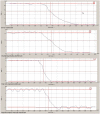Toothbrush abrasivity in a long-term simulation on human dentin depends on brushing mode and bristle arrangement
- PMID: 28222156
- PMCID: PMC5319671
- DOI: 10.1371/journal.pone.0172060
Toothbrush abrasivity in a long-term simulation on human dentin depends on brushing mode and bristle arrangement
Abstract
Objective: The aim of this study was to evaluate the susceptibility of dentin to brushing abrasion using four different toothbrushes (rotating-oscillating, sonic and two types of manual toothbrushes) with the same brushing forces.
Methods: Dentin samples (n = 72) were selected from 72 impacted third molars. Half of the surface of dentin samples was covered with an adhesive tape, creating a protected and a freely exposed area in the same specimen. Brushing was performed with either a: sonic (Sonicare PowerUp, Philips GmbH, Hamburg, Germany), b: oscillating-rotating (Oral B Vitality Precisions Clean, Procter & Gamble, Schwalbach am Taunus, Germany) or two different manual toothbrushes c: flat trim brush head toothbrush (Dr. Best: Original, Glaxo-Smith-Kline, Bühl, Germany) and d: rippled-shaped brush head toothbrush (Blend-a-Dent, Complete V-Interdental, Blend-a-med, Schwalbach, Germany) in a custom made automatic brushing machine. The brushing force was set to 2 N and a whitening toothpaste (RDA = 150) was used. The simulation period was performed over a calculated period to mimic a brushing behavior of two times a day brushing for eight years and six months. Dentin loss was quantitatively determined by profilometry and statistically analyzed by Wilcoxon and Mann-Whitney-U Test (p < 0.05).
Results: The mean (standard deviation) surface loss was 21.03 (±1.26) μm for the sonic toothbrush, 15.71 (±0.85) μm for the oscillating-rotating toothbrush, 6.13 (±1.24) μm for the manual toothbrush with flat trim brush head and 2.50 (±0.43) μm for the manual toothbrush with rippled-shaped brush head. Differences between all groups were statistically significant at p<0.05.
Conclusion: Using the same brushing force and a highly abrasive toothpaste, manual toothbrushes are significantly less abrasive compared to power toothbrushes for an 8.5-year simulation.
Conflict of interest statement
Figures





Similar articles
-
Brushing force of manual and sonic toothbrushes affects dental hard tissue abrasion.Clin Oral Investig. 2013 Apr;17(3):815-22. doi: 10.1007/s00784-012-0788-z. Epub 2012 Jul 13. Clin Oral Investig. 2013. PMID: 22791283
-
Influence of rotating-oscillating, sonic and ultrasonic action of power toothbrushes on abrasion of sound and eroded dentine.J Periodontal Res. 2006 Jun;41(3):221-7. doi: 10.1111/j.1600-0765.2005.00850.x. J Periodontal Res. 2006. PMID: 16677292
-
Influence of Bristle Stiffness of Manual Toothbrushes on Eroded and Sound Human Dentin--An In Vitro Study.PLoS One. 2016 Apr 12;11(4):e0153250. doi: 10.1371/journal.pone.0153250. eCollection 2016. PLoS One. 2016. PMID: 27070901 Free PMC article.
-
Plaque removal efficacy of oscillating-rotating power toothbrushes: review of six comparative clinical trials.Am J Dent. 2013 Apr;26(2):68-74. Am J Dent. 2013. PMID: 24073528 Review.
-
The role of oral hygiene: does toothbrushing harm?Monogr Oral Sci. 2014;25:215-9. doi: 10.1159/000360379. Epub 2014 Jun 26. Monogr Oral Sci. 2014. PMID: 24993269 Review.
Cited by
-
Dentin tubule obturation of a bioglass-based dentin desensitizer under repeated exposure to lactid acid and brushing.BMC Oral Health. 2019 Dec 5;19(1):274. doi: 10.1186/s12903-019-0962-7. BMC Oral Health. 2019. PMID: 31805922 Free PMC article. Clinical Trial.
-
Acrylated Hydroxyazobenzene Copolymers in Composite-Resin Matrix Inhibits Streptococcus mutans Biofilms In Vitro.Pediatr Dent. 2021 Nov 15;43(6):484-491. Pediatr Dent. 2021. PMID: 34937621 Free PMC article.
-
Characterizing the Content Related to Oral Health Education on TikTok.Int J Environ Res Public Health. 2021 Dec 16;18(24):13260. doi: 10.3390/ijerph182413260. Int J Environ Res Public Health. 2021. PMID: 34948869 Free PMC article.
-
Effectiveness of Papain-Based Organic Dentifrices Versus Commercial Whitening Dentifrice on Tea-Induced Tooth Stains: An In Vitro Study.Cureus. 2024 Sep 11;16(9):e69225. doi: 10.7759/cureus.69225. eCollection 2024 Sep. Cureus. 2024. PMID: 39398685 Free PMC article.
-
Biomimetic Whitening Effect of Polyphosphate-Bleaching Agents on Dental Enamel.Biomimetics (Basel). 2022 Oct 29;7(4):183. doi: 10.3390/biomimetics7040183. Biomimetics (Basel). 2022. PMID: 36412711 Free PMC article.
References
-
- Shay K. The evolving impact of aging America on dental practice. J Contemp Dent Pract. 2004;5(4):101–110. - PubMed
-
- Kuroe T, Caputo AA, Ohata N, Itoh H. Biomechanical effects of cervical lesions and restoration on periodontally compromised teeth. Quintessence Int. 2001;32(2):111–118. - PubMed
-
- Lee WC, Eakle WS. Stress-induced cervical lesions: review of advances in the past 10 years. J Prosthet Dent. 1996;75(5):487–494. Epub 1996/05/01. - PubMed
MeSH terms
LinkOut - more resources
Full Text Sources
Other Literature Sources

